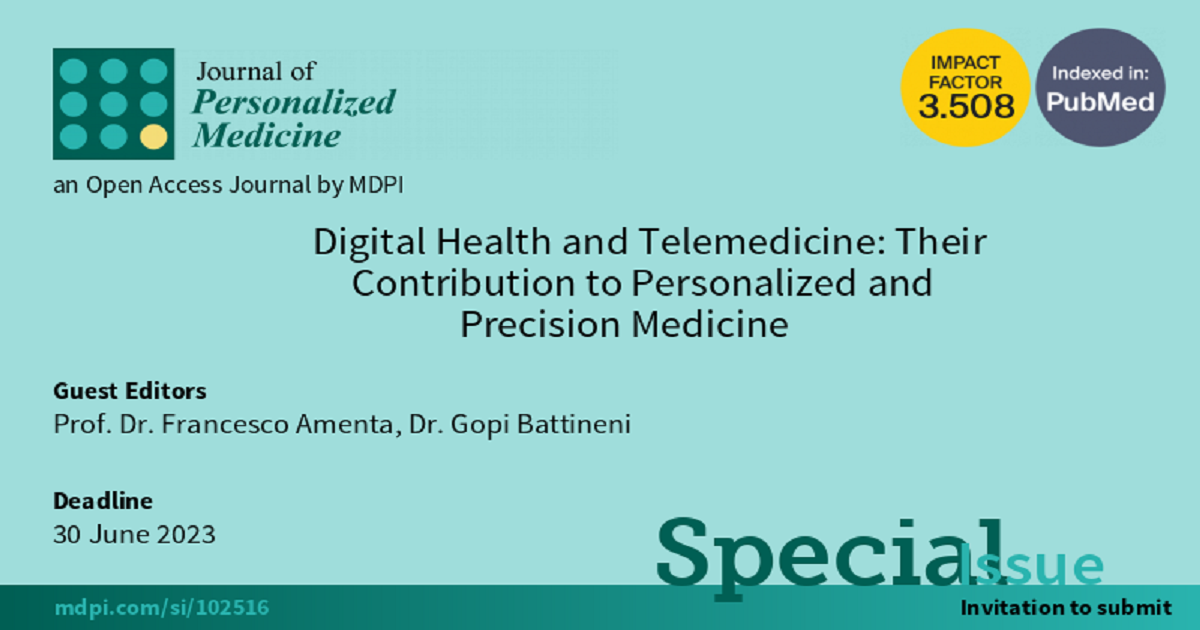Digital Health and Telemedicine: Their Contribution to Personalized and Precision Medicine
A special issue of Journal of Personalized Medicine (ISSN 2075-4426). This special issue belongs to the section "Methodology, Drug and Device Discovery".
Deadline for manuscript submissions: closed (30 June 2023) | Viewed by 54368

Special Issue Editors
Interests: human–computer interaction; neuro sciences; telemedicine; remote consultation; pharmacology
Interests: artificial intelligence; e-health; machine learning; medical informatics; Python; tele-healthcare; tele-robotics
Special Issue Information
Dear Colleagues,
Digital health and telemedicine are main applications of Information and Communication Technology (ICT) in healthcare and are playing an increasingly important role for health systems. These technologies are considered as strategic objectives of innovation, growth and employment plans. A cultural commitment resulting in the widespread use of these technologies in daily practice is important for enlarging their applications in health care, such as telehealth and digital telemedicine.
In recent years, there has been growing interest in the development of personalized and precision medicine approaches in the prevention and treatment of several pathologies with the purpose to offer patients “the right treatment, to the right patient, at the right time.” Digital health and telemedicine, if properly used, may offer advantages for both patients and health professionals in the delivery of medical services, where distance is a basic factor. Thanks to these technologies, all medical care experts can use ICT for the exchange of adequate information for treatment, diagnosis and avoidance of illness and wounds, exploration and assessment and for the proceeding with the instruction of medical care suppliers with the purpose of strengthening individuals’ health and their networks.
Personalized medicine via telemedicine can offer personal medications or treatment that can be suggested over video or phone conversations with a pill dispenser at hand. Family members or friends (from different locations) can participate in these conversations and understand expert suggestions for improving the health literacy of the entire family.
The proposed Special Issue collects the most recent insights into basic and clinical research on this topic, opening new perspectives towards modern approaches in personalized and precision medicine primarily for the advantage of people that for any reasons may have difficulties in accessing high quality medical assistance.
Prof. Dr. Francesco Amenta
Dr. Gopi Battineni
Guest Editors
Manuscript Submission Information
Manuscripts should be submitted online at www.mdpi.com by registering and logging in to this website. Once you are registered, click here to go to the submission form. Manuscripts can be submitted until the deadline. All submissions that pass pre-check are peer-reviewed. Accepted papers will be published continuously in the journal (as soon as accepted) and will be listed together on the special issue website. Research articles, review articles as well as short communications are invited. For planned papers, a title and short abstract (about 100 words) can be sent to the Editorial Office for announcement on this website.
Submitted manuscripts should not have been published previously, nor be under consideration for publication elsewhere (except conference proceedings papers). All manuscripts are thoroughly refereed through a single-blind peer-review process. A guide for authors and other relevant information for submission of manuscripts is available on the Instructions for Authors page. Journal of Personalized Medicine is an international peer-reviewed open access monthly journal published by MDPI.
Please visit the Instructions for Authors page before submitting a manuscript. The Article Processing Charge (APC) for publication in this open access journal is 2600 CHF (Swiss Francs). Submitted papers should be well formatted and use good English. Authors may use MDPI's English editing service prior to publication or during author revisions.
Keywords
- digital health
- telemedicine
- remote medical diagnosis
- digital transmission of medical care
- ICT systems in medicine
- precision care
- second and third opinion teleconsultations







